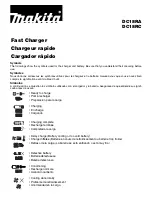
3
Symbols
The followings show the symbols used for the charger and battery. Be sure that you understand their meaning before use.
Specifications
• Manufacturer reserves the right to change specifications without notice.
• Note: Specifications may differ from country to country.
• Weight according to EPTA-Procedure 01/2003.
IMPORTANT SAFETY INSTRUCTIONS
CAUTION:
1.
SAVE THESE
INSTRUCTIONS
– This
manual contains important safety and operating
instructions for battery charger.
2. Before using battery charger, read all instructions and
cautionary markings on (1) battery charger, (2) battery,
and (3) product using battery.
3. CAUTION – To reduce risk of injury, charge only MAKITA
rechargeable batteries marked on the charger label.
Other types of batteries may burst causing personal injury
and damage.
4. Non-rechargeable batteries cannot be charged with this
battery charger.
5. Use a power source with the voltage specified on the
nameplate of the charger.
6. Do not charge the battery cartridge in presence of
flammable liquids or gases.
7. Do not expose charger to rain or snow.
8. Never carry charger by cord or yank it to disconnect from
receptacle.
9. After charging or before attempting any maintenance or
cleaning, unplug the charger from the power source. Pull
by plug rather than cord whenever disconnecting charger.
10. Make sure cord is located so that it will not be stepped on,
tripped over, or otherwise subjected to damage or stress.
11. Do not operate charger with damaged cord or plug. If the
cord or plug is damaged, ask Makita authorized service
center to replace it in order to avoid a hazard.
12. Do not operate or disassemble charger if it has received a
sharp blow, been dropped, or otherwise damaged in any
way; take it to a qualified serviceman. Incorrect use or
reassembly may result in a risk of electric shock or fire.
13. The battery charger is not intended for use by young
children or infirm persons without supervision.
14. Young children should be supervised to ensure that they
do not play with the battery charger.
15. Do not charge battery cartridge when room temperature
is BELOW 10°C (50°F) or ABOVE 40°C (104°F). When
the battery temperature is under 0°C (32°F), charging
may not start.
16. Do not attempt to use a step-up transformer, an engine
generator or DC power receptacle.
Charging (Fig. 1)
This charger can charge at most two batteries at the same
time. Left two ports and right two ports of the charger consist
pairs respectively. One pair can charge a battery at one time.
For example, if you insert the batteries in port 1 and 3, the
charger starts charging those two batteries at the same time.
However, if you insert the batteries in port 1 and 2, the
charger starts charging only port 1. Charging of port 2 starts
after the charging of battery in port 1 completes.
1. Plug the battery charger into the proper AC voltage
source. Charging lights start blinking rapidly in green
color.
2. Insert the battery cartridge into the charger until it stops.
Terminal cover of the charger automatically opens as you
insert the battery cartridge.
3. The charging light on the port changes into red color, and
charging starts shortly after.
Note:
Notice the charging light on the port of the pair starts
blinking ‘slowly’ when you insert a battery. If you insert a
battery into the pair port, which charging light is blinking
slowly in green, the charging light starts blinking in red
color, and the port becomes stand-by status. Charging on
the pair port starts after completion of charging on the first
port.
4. As charging progress, the both red and green color light
up. And with completion of charging, green color lights
up.
Note:
Charging time varies by temperature (10°C (50°F) – 40°C
(104°F)) and condition of the battery cartridge, such as a
battery cartridge which is new or has not been used for a
long period of time.
5. After charging all batteries, remove the battery cartridges
from charger and unplug the charger.
ENGLISH
• Ready to charge
• Charging
• Charging complete
• Delay charge (Battery cooling or too cold
battery, waiting for charging)
• Deffective battery
• Do not short batteries.
Model
DC18SF
Input
A.C. 120 V 50 – 60 HZ
Output
D.C. 14.4 V – 18 V
Weight
2.1 kg (4.561 lbs)


























